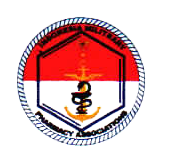HOW EFFECTIVE IS INDONESIA'S STRATEGIC HEDGING APPROACH?
(1) Indonesian Navy Fellow of the Australian Defence Strategic Studies Course 2024
(*) Corresponding Author
Abstract
Keywords
Full Text:
PDFReferences
Pacific? Middle power strategies from Australia, South Korea and Indonesia. International Affairs, 98(2), 403–421. https://doi.org/10.1093/ia/iiab231
Agastia, I. G. B. D. (2020). Understanding Indonesia’s role in the ‘ASEAN Outlook on the Indo‐Pacific’: A role theory approach. Asia & the Pacific Policy Studies, 7(3), 293–305. https://doi.org/10.1002/app5.308
Albanese, A. (2024). PM Speech: Future Ready Australia. https://www.pm.gov.au/media/future-made-australia
Ambarsari, K. W., Sumarlan, S., & Dwiyanto, H. (2021). The Indonesia Defense Diplomacy to Spain Year 2014-2018 Toward The Cooperation in The Fulfilment of Defense and Security Equipment. Jurnal Pertahanan: Media Informasi tentang Kajian & Strategi Pertahanan Yang Mengedepankan Identity, Nasionalism & Integrity, 7(2), 232. https://doi.org/10.33172/jp.v7i2.1184
Anwar, D. F. (2023). Indonesia’s hedging plus policy in the face of China’s rise and the US-China rivalry in the Indo-Pacific region. The Pacific Review, 36(2), 351–377. https://doi.org/10.1080/09512748.2022.2160794
Arkyasa, M. (2023, May 31). Pertamina Hulu Energi awarded management of East Natuna WK. Indonesia Business Post. https://indonesiabusinesspost.com/risks-opportunities/pertamina-hulu-energi-awarded-management-of-east-natuna-wk/
Aulawi, M. H., Sarnawa, B., & Islami, M. N. (2022). North Natuna Sea Naming After South China Sea From The International Law Perspective. Journal of Law Science, 18, No.2.
Bevint, V. (2018, September 5). ‘I’m nasty.’ How an Indonesian Government Official Won Admirers by Blowing Up Boats. The Washington Post, World Views. https://www.washingtonpost.com/world/2018/09/05/im-nasty-how-an-indonesian-government-official-won-admirers-by-blowing-up-boats/
Cheney-Peters, S. (2014, December 15). Opinion: The Expanding Assault on China’s South China Sea Claims. US Naval Institute News, Trending Topics. https://news.usni.org/2014/12/15/opinion-expanding-assault-chinas-south-china-sea-claims
Ciorciari, J. D. (2008). The balance of great-power influence in contemporary Southeast Asia. International Relations of the Asia-Pacific, 9(1), 157–196. https://doi.org/10.1093/irap/lcn017
Da Costa, A. B., Lamb, K., & Allard, T. (2021, December 2). EXCLUSIVE China protested Indonesian drilling, military exercises. Reuters. https://www.reuters.com/world/asia-pacific/exclusive-china-protested-indonesian-drilling-military-exercises-2021-12-01/
Damuri, Y. R., Perkasa, V., Atje, R., & Hirawan, F. (n.d.). Understanding Local Perspectives, Capacity, and Governanve. Centre for Strategic and International Studies, 2019. https://www.jstor.org/stable/resrep25409.1
Denny, R. (2005). Southeast Asia and China: Balancing or Bandwagoning? Contemporary Southeast Asia, 27(2), 306. http://www.jstor.org/stable/25798738
Dwiwicaksoputro, W., Gunadi, G. I., Soraya, N. A., & Deksino, G. R. (2023). Transfer of Technology Process between Indonesia and France. 6(1).
Exner, G. (2023, May 9). Quality vs Quantity in Military Production. Providence. https://providencemag.com/2023/05/quality-vs-quantity-in-military-production/
Galeon, A. P. N. (2022, November 24). US, Indonesia to Increase Military Interoperability. The Defense Post. https://www.thedefensepost.com/2022/11/24/us-indonesia-interoperability/
Goh, E. (2005). Meeting the China Challenge: The U.S. in Southeast Asian Regional Security Strategies. East-West Center Washington, 24. http://www.jstor.com/stable/resrep06541
Hidayat, M. R. (2020, January 13). TNI confirms Chinese vessels have exited Indonesian EEZ. Antara. https://en.antaranews.com/news/139611/tni-confirms-chinese-vessels-have-exited-indonesian-eez
Karim, M. F. (2018). Middle power, status-seeking and role conceptions: The cases of Indonesia and South Korea. Australian Journal of International Affairs, 72(4), 343–363. https://doi.org/10.1080/10357718.2018.1443428
Khoo, N. (2022). Great power Rivalry and Southeast Asian agency: Southeast Asia in an Era of US-China strategic competition. Political Science, 74(2–3), 141–154. https://doi.org/10.1080/00323187.2023.2186251
Koga, K. (2017). The Concept of “Hedging” Revisited: The Case of Japan’s Foreign Policy Strategy in East Asia’s Power Shift. Oxford University Press, 20. https://doi.org/10.1093/isr/vix059
Kuik, C.-C. (2015). Variations on a (Hedging) Theme: Comparing ASEAN Core States’ Alignment Behavior. Research Gate Joint U.S.-Korea Academic Studies. https://www.researchgate.net/publication/289637790
Kuik, C.-C. (2021). Getting hedging right: A small-state perspective. China International Strategy Review, 3(2), 300–315. https://doi.org/10.1007/s42533-021-00089-5
Kuik, C.-C. (2022). Hedging via Institutions: ASEAN-led Multilateralism in the Age of the Indo-Pacific. Asian Journal of Peacebuilding, 10(2), 355–386. https://doi.org/10.18588/202211.00a319
Laksmana, E. A. (2021). A Fragile Fulcrum: Indonesia-U.S. Military Relations in the Age of Great-Power Competition. Asia Policy, 16(4), 106–114. https://doi.org/10.1353/asp.2021.0057
McNeil, H. (2024, January 24). Indonesia boosts air defense with C-130J-30 Super Hercules aircraft. Air Force Technology. https://www.airforce-technology.com/news/indonesia-boosts-air-defense-with-c-130j-30-super-hercules-aircraft/
McRae, D. (2019). Indonesia’s South China Sea Diplomacy: A Foreign Policy Illiberal Turn? Journal of Contemporary Asia, 1–21. https://doi.org/10.1080/00472336.2019.1601240
Medeiros, E. S. (2005). Strategic hedging and the future of Asia‐pacific stability. The Washington Quarterly, 29(1), 145–167. https://doi.org/10.1162/016366005774859724
Mubah, A. S. (2019). Indonesia’s Double Hedging Strategy toward the United States–China Competition: Shaping Regional Order in the Indo-Pacific? Issues & Studies, 55(04), 1940007. https://doi.org/10.1142/S1013251119400071
Mursitama, T. N., & Ying, Y. (2021). Indonesia’s Perception and Strategy toward China’s OBOR Expansion: Hedging with Balancing. The Chinese Economy, 54(1), 35–47. https://doi.org/10.1080/10971475.2020.1809816
Naval News. (2024, January 23). Indonesian Shipyard Lays Keel For Philippine Navy’s LPD. Naval News. https://www.navalnews.com/naval-news/2024/01/indonesian-shipyard-lays-keel-for-philippine-navys-lpd/
Nugraha, M. H. R. (2017). Indonesian Future Strategic Defense Planning. Jurnal Pertahanan, 3(3), 207. https://doi.org/10.33172/jp.v3i3.217
Ploberger, C. (2017). One Belt, One Road – China’s new grand strategy. Journal of Chinese Economic and Business Studies, 15(3), 289–305. https://doi.org/10.1080/14765284.2017.1346922
Pratiwi, F. I., Puspitasari, I., Hikmawati, I., & Bagus, H. (2021). Global Maritime Fulcrum: Indonesia’s Middle Power Strategy Between Belt And Road Initiatives (BRI) and Free-Open Indo Pacific (FOIP). Central European Journal of International and Security Studies, 15(3), 30–54. https://doi.org/10.51870/CEJISS.A150302
Rosyidin, M. (2017). Foreign policy in changing global politics: Indonesia’s foreign policy and the quest for major power status in the Asian Century. South East Asia Research, 25(2), 175–191. https://doi.org/10.1177/0967828X17706570
Sukadis, B. (2021, September 23). Protecting Indonesia’s Sovereignty in the North Natuna Sea. The Diplomat, Asian Beat. https://thediplomat.com/2021/09/protecting-indonesias-sovereignty-in-the-north-natuna-sea/
Tan, S. S. (2020). Consigned to hedge: South-east Asia and America’s ‘free and open Indo-Pacific’ strategy. International Affairs, 96(1), 131–148. https://doi.org/10.1093/ia/iiz227
Tarigan, E. (2020, September 15). Indonesian patrol confronts Chinese ship in economic zone. The Washington Post. https://www.washingtonpost.com/world/asia_pacific/indonesian-patrol-confronts-chinese-ship-in-economic-zone/2020/09/15/70f6e96e-f725-11ea-85f7-5941188a98cd_story.html
Tsang, S. (2025, March 12). China can live with Trump’s tariffs – his bullish foreign policy will help Beijing in the long term. The Guardian. https://www.theguardian.com/commentisfree/2025/mar/12/donald-trump-foreign-policy-china-tariffs-beijing-xi-jinping?
U.S. Department of Defense News. (2023, September 26). It’s Not Called Super Garuda Shield for Nothing! US Department of Defense News. https://www.defense.gov/News/Feature-Stories/Story/Article/3538016/its-not-called-super-garuda-shield-for-nothing/
Wenas Inkiriwang, F. (2021). Multilateral Naval Exercise Komodo: Enhancing Indonesia’s Multilateral Defense Diplomacy? Journal of Current Southeast Asian Affairs, 40(3), 418–435. https://doi.org/10.1177/18681034211008905
Wicaksono, A. P. (2022). Policy Effectiveness: Defense Cooperation Study of Indonesia-China. Journal of Social Science, 1(3). https://joss.al-makkipublisher.com/index.php/js
Yeo, M. (2017, December 19). First AH-64E Apache Guardian for Indonesia arrives from US. Defense News Air Warfare. https://www.defensenews.com/air/2017/12/18/first-ah-64e-apache-guardian-for-indonesia-arrives-from-us/
Yoshimatsu, H. (2023). ASEAN and Great Power Rivalry in Regionalism: From East Asia to the Indo-Pacific. Journal of Current Southeast Asian Affairs, 42(1), 25–44. https://doi.org/10.1177/18681034221139297
Yuniar, R. W., & Siouw, M. (2023, January 12). China ‘sending a signal’ by deploying largest coastguard vessels near Indonesia’s Natuna. South China Morning Post, This Week in Asia: Politics. https://www.scmp.com/week-asia/politics/article/3206445/china-sending-signal-deploying-largest-coastguard-vessels-near-indonesias-natunas?campaign=3206445&module=perpetual_scroll_0&pgtype=article
DOI: https://doi.org/10.33172/jpbh.v15i1.19841
Copyright (c) 2025 Yusa Adi Hartanto
INDEXED BY:
Office Address:
Lembaga Penelitian dan Pengabdian Kepada Masyarakat
Republic of Indonesia Defense University
Jl. Salemba Raya No.14, Paseban,Jakarta Pusat, Daerah Khusus Ibukota Jakarta 10440, Indonesia
Email: jurnal.unhan@idu.ac.id
Creative Commons Attribution (CC-BY-NC-SA)

This work is licensed under a Creative Commons Attribution-NonCommercial-ShareAlike 4.0 International License.
View Jurnal Pertahanan dan Bela Negara Stats





